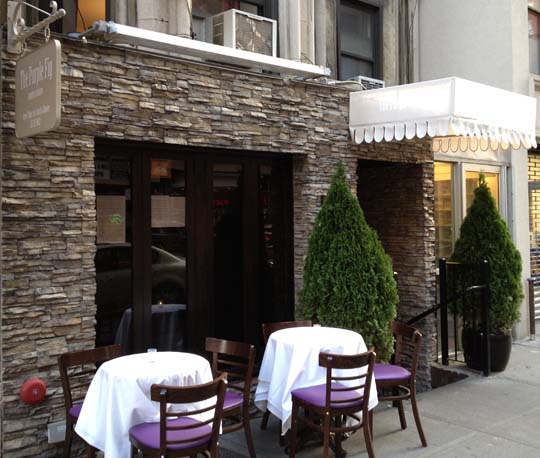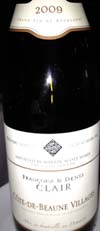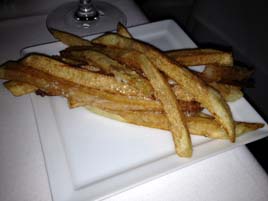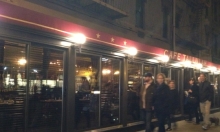
Note: After a brief late-summer closure in late August 2012, the Purple Fig re-opened in September with a “more simple” menu. We liked our visit (when the original menu was still available), but the consensus of most other reviewers was negative.
By December 2012, the space had reverted back to its former name, P. D. O’Hurley’s. That experiement lasted less than three months, before the restaurant was seized by the marshall, presumably for non-payment of taxes. The space was closed as of June 2013, but the 70-year-old Emerald Inn is expected to relocate there.
*
 You’ve got to give credit to the team behind The Purple Fig, the cute new French bistro on the Upper West Side. Nothing they’re serving, nor the style in which they are serving it, is remotely fashionable. So they’ve opened this new restaurant for the best possible reason: because they believe in it.
You’ve got to give credit to the team behind The Purple Fig, the cute new French bistro on the Upper West Side. Nothing they’re serving, nor the style in which they are serving it, is remotely fashionable. So they’ve opened this new restaurant for the best possible reason: because they believe in it.
But one must ask where the customers will come from. It’s too fancy to bring the kids, not quite good enough to be a destination, not edgy enough to attract a younger crowd, a tad too far from Lincoln Center to be an obvious pre-theater place, and too expensive to be a neighborhood standby.
 After you subtract all the potential guests I’ve just excluded, are there enough remaining to make a go of it? I hope so. The Purple Fig, though not yet great, is promising. In a town where new French restaurants are scarce, you want to root for every one.
After you subtract all the potential guests I’ve just excluded, are there enough remaining to make a go of it? I hope so. The Purple Fig, though not yet great, is promising. In a town where new French restaurants are scarce, you want to root for every one.
Prices, for this location, are a bit dear, with appetizers $9.95–20.95, entrées $23.95–36.95, and side dishes $5.95. Every price ends in “.95,” an outdated and unendearing conceit.
The chef, Conrad Gallagher, was last seen in New York at the now-closed Peacock Alley. A rendition of the Purple Fig in Dublin won him a Michelin star.
Calling it a “modern bistro,” he serves an eccentric menu, with concoctions like: Deep Fried Soft Duck Egg with Polenta, Soft Blood Pudding, Frisée Salad with Prosciutto, Lemon Oil Emulsion.
 That’s just one dish. Most others feature similar long lists of ingredients. And you wonder: How’s that going to work?
That’s just one dish. Most others feature similar long lists of ingredients. And you wonder: How’s that going to work?
One might begin with that old standby, the “Goats [sic] Cheese Salad,” served here with wild rocket, confit tomatoes, toasted garlic, pumpkin seeds and marinated figs ($9.95; above right).
Here, the goat cheese sits atop a tiny puff pastry, instead of being integrated into the salad. I don’t consider that an improvement, though I must report: my girlfriend loved the dish.


I much admired a Goose Liver Parfait ($12.95; above left), with fig marmalade, spinach salad, apricot compote, and hazelnut aioli, served with perhaps the best brioche I’ve ever been served with this type of dish (above right), so thick and hearty it could have been French toast.


My girlfriend and I had the same entrée, the Roasted Muscovy Duck Breast ($26.95; above left), with poached figs, butternut purée, lentils, a quail egg, and green apple salad. She liked it far better than I did. The duck was fine enough, but the lentils tasted bitter, and the dish felt like a pile of unintegrated ingredients. I wasn’t fond (and have never been fond) of the blob of baby food shaped like the point of a spear.
The chef has a fondness for figs: quite inadvertently, they figured in all three dishes we ordered. I guess the place has “fig” in the name for a reason.
The kitchen sent out a plate of the French Fries with Truffle Aioli (normally $5.95; above right). I assumed they came with the duck or were comped, until they appeared on the bill—removed, in all fairness, after I pointed out the error. I’m glad I didn’t pay for them, as they were soggy and not warm enough.
The wine list, as at many new restaurants, doesn’t have much personality. Running to just a page, it’s a list of safe, unremarkable bottles, with no geographic or thematic unity. It isn’t even majority-French. I suspect a consultant put it together.
The space is smartly decorated, in a purple motif that isn’t at all obtrusive, but with its white tablecloths and dim lighting, the space feels fancier than it needs to be. The dining room was about half full on a Friday evening. A handsome long bar wasn’t occupied at all.
Some early message board reports complained about the service, but two months in those issues have been rectified. The staff (most speak with French accents) now seem on top of their game. Aside from the one dish billed in error, we had no complaints. The restaurant is a work in progress, but good enough to be worth a second visit a few months from now.
The Purple Fig (250 W. 72nd St., west of Broadway, Upper West Side)
Food: Modern “eccentric” French
Wine: A generic unfocused list; adequate, but could be better
Service: Mostly very good
Ambiance: An upscale spot that feels fancier than it needs to be
Rating: ★
Why? Not destination cuisine, but worth keeping an eye on
 Tuesday, December 24, 2013 at 05:02PM
Tuesday, December 24, 2013 at 05:02PM 
 I’ve never built or run a restaurant, but I’m gonna go out on a limb, and give some advice: don’t tell the press that you’re building a new Balthazar or Elaine’s. Those two places are too iconic – too legendary –to be copied. The attempt is bound to seem pale by comparison.
I’ve never built or run a restaurant, but I’m gonna go out on a limb, and give some advice: don’t tell the press that you’re building a new Balthazar or Elaine’s. Those two places are too iconic – too legendary –to be copied. The attempt is bound to seem pale by comparison. That’s exactly what Greg Hunt, owner of Cafe Tallulah on the Upper West Side, did. Florence Fabricant of The Times duly reported it. Hunt hired Roxanne Spruance, a sous chef from Blue Hill Stone Barns (and previously WD~50) to run the kitchen. An Employees Only alumnus was in charge of the cocktails. With that background, the critics were sure to turn up, right?
That’s exactly what Greg Hunt, owner of Cafe Tallulah on the Upper West Side, did. Florence Fabricant of The Times duly reported it. Hunt hired Roxanne Spruance, a sous chef from Blue Hill Stone Barns (and previously WD~50) to run the kitchen. An Employees Only alumnus was in charge of the cocktails. With that background, the critics were sure to turn up, right?























































